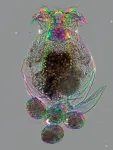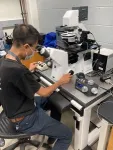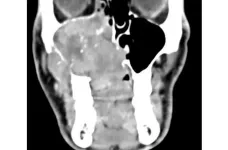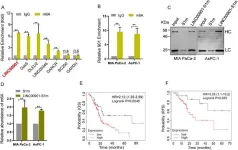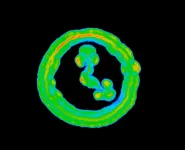(Press-News.org) By Wynne Parry
Much about tiny, swimming rotifers makes them ideal study subjects. Although barely visible to the naked eye, these transparent animals and their innards are readily viewed under a microscope. What’s more, they grow readily in laboratory culture, offering scientists an otherwise difficult-to-obtain perspective from their corner of the animal kingdom.
However, while rotifers have been used experimentally for more than a century by many research groups, scientists have so far lacked the ability to readily manipulate rotifers’ genetics, placing a hard limit on the experiments they can run with these animals.
A joint effort by Kristin Gribble and David Mark Welch at the Marine Biological Laboratory (MBL) has overcome this challenge by devising a method for precisely altering the rotifers’ genomes using the gene editing system CRISPR-Cas9. In experiments described in PLOS Biology, their team edited two genes and added a genetic sequence to produce changes that the rotifers passed down through generations.
“Our method turns out to be a very practical way to generate a large number of genetically altered rotifers fairly quickly,” said Mark Welch, a senior scientist at MBL and director of the Josephine Bay Paul Center for Comparative Molecular Biology and Evolution.
Not only will this advance benefit his lab and Gribble’s, which use rotifers to study the biology of aging, DNA repair mechanisms, and other fundamental questions, it will “open the field to allow more people to work with these animals,” Mark Welch said.
Developing a microscopic, water-dwelling lab animal
Certain living things — the bacterium E. coli, fruit flies, and mice, for example — have become well established as model organisms that scientists routinely use in research. Taken together, however, they don’t adequately represent the full diversity of life.
The MBL team aims to add rotifers to this group of genetically tractable organisms because, as tiny invertebrates with close ties to the ancestors of modern animals, they offer an important perspective on evolution, development, and other aspects of biology.
To develop rotifers as model organisms, researchers need the capacity to tweak these animals’ genomes. In 2017, MBL Interim Director Melina Hale of University of Chicago provided Gribble and Mark Welch with funding to devise a method for doing so using CRISPR-Cas9. The goal of cultivating a greater variety of model organisms later became formalized as MBL’s New Research Organisms initiative.
Now widely employed in research, CRISPR-Cas9 makes precise cuts within DNA, which researchers use to shut down or alter genes. First, however, they must get the CRISPR system into the animals.
Fine-sawdust-sized specks darting about in water, rotifers make for unusually challenging targets. After many unsuccessful attempts to hold them still, first author Haiyang Feng, then a postdoctoral scientist at MBL, devised a solution: By immersing them in a high-viscosity solution and administering a low level of an anesthetic, he slowed the animals enough to grab them one at a time with light suction through a hollow needle.
With the animal, always a female, in place, he injected the gene editing system into the part of its body that supplies nutrients to the eggs. The offspring that hatched from these eggs then carried the mutations, which they passed on to their offspring.
In this way, the team inactivated vasa, a gene crucial to animal development, causing the rotifers to stop reproducing after a few generations. By turning off a second gene, mlh3, they prevented the rotifers from producing male offspring. And, finally, by adding a section of genetic code containing “stop” instructions into mlh3, they achieved the same effect.
New possibilities for rotifer research
Both researchers intend to use the CRISPR-based method to genetically alter rotifers for their own research. As part of her work exploring how mothers’ age can affect the traits of their offspring, Gribble, an associate scientist at MBL, is investigating the role of mitochondria, the energy-producing component of cells. The new approach will allow her to tag or alter mitochondria. Mark Welch, meanwhile, plans to use it to explore the molecular mechanisms behind one rotifer species’ ability to revive after completely drying out, including how they repair damage to their DNA.
Studies like these are only the beginning. “This new tool, along with the ease of raising rotifers in the lab, will make it possible to use them to answer lots of questions we aren’t even thinking about yet,” Gribble says.
###
The Marine Biological Laboratory (MBL) is dedicated to scientific discovery – exploring fundamental biology, understanding marine biodiversity and the environment, and informing the human condition through research and education. Founded in Woods Hole, Massachusetts in 1888, the MBL is a private, nonprofit institution and an affiliate of the University of Chicago.
END
The Ecological Society of America has named Elisabeth Huber-Sannwald, Ph.D., as the editor-in-chief of the newest title in its portfolio of journals. The international open-access journal, Earth Stewardship, will focus on facilitating collaborations between scientists and society to shape a sustainable future for nature and people. It will be ESA’s first publication focused on integrating the natural and social sciences; the humanities; and technical, local and Indigenous Knowledges.
Earth Stewardship will highlight perspectives from the southern ...
The Ecological Society of America (ESA) will present its 16th annual Regional Policy Award to the Director for the Confederated Tribes of the Umatilla Indian Reservation’s (CTUIR) Department of Natural Resources Eric Quaempts on Sunday, Aug 6, 5:00pm EDT, during the ESA Conference Opening Plenary. The ESA annual award recognizes the use of ecological science to inform regional policy decisions. This is the first time in the history of the ESA policy award that a Tribal member and Tribal governance employee has been recognized for integrating tribal ecological approaches.
Since ...
BOSTON - A new way to monitor two-photon lithography nanoscale fabrication could help improve the accuracy and efficiency of creating 3D engineered tissue scaffolds, according to a new study. Tissue scaffolds mimic the natural extracellular matrices found in the body, which creates a 3D environment ideal for tissue formation.
Jieliyue Sun, an engineering Ph.D. student from the lab of Kimani Toussaint, Brown University will present this research at the Optica Imaging Congress. The hybrid meeting will take place 14 – 17 August 2023 in Boston.
“Tissue scaffolds are three-dimensional structures that can support the growth and development of cells or tissues for biomedical ...
Highlights:
Researchers led by Rafael Auras in the Michigan State University School of Packaging have shown how to make a bio-based polymer compostable in both home and industrial settings.
The team said its research, published in ACS Sustainable Chemistry & Engineering, can help divert plastic packaging that’s been soiled by food, the vast majority of which is not recycled. Another end-of-use option, like composting, can thus help keep plastics out of landfills and the environment.
To make the compostable polymer, the team blended bioplastics known as polylactic acid, or PLA, and thermoplastic ...
“Proton therapy [...] seems to have decisive advantages with regard to the long-term survival of [adenoid cystic carcinoma] [...]”
BUFFALO, NY- August 4, 2023 – A new editorial paper was published in Oncoscience (Volume 10) on June 28, 2023, entitled, “Adenoid cystic carcinoma of the head and neck – treatment strategies of a highly malignant tumor with variable localizations.”
In this new editorial, researchers Florian Dudde, Kai-Olaf Henkel and Filip Barbarewicz from the Army Hospital Hamburg discuss head and neck tumors, which are among the most common malignancies. ...
Researchers have modified a commercial virtual reality headset, giving it the ability to measure brain activity and examine how we react to hints, stressors and other outside forces.
The research team at The University of Texas at Austin created a noninvasive electroencephalogram (EEG) sensor that they installed in a Meta VR headset that can be worn comfortably for long periods. The EEG measures the brain's electrical activity during the immersive VR interactions.
The device could be used in many ways, ...
Chemical modifications of RNA molecules, such as m6A, can critically impact gene expression, influencing various aspects of cancer development and progression. However, while studies into m6A modification of messenger RNA (mRNA) have been extensive, exploration of its impact on lncRNAs, especially within the context of PDAC, has been relatively limited.
In an innovative study published in the Genes & Diseases journal, a team from the The Children's Hospital, Zhejiang University School of Medicine, People's Hospital of Hangzhou Medical College and University of Mississippi Medical Center employed a methylated RNA immunoprecipitation ...
In an effort to address health disparities linked to low socioeconomic environments, a University of Massachusetts Amherst kinesiologist is partnering with Western Massachusetts preschools to implement a physical activity program for young children.
Sofiya Alhassan, professor of kinesiology in the School of Public Health and Health Sciences, will measure the impact of a gross motor skills-based physical activity program on the cognitive development of 3- to 5-year-olds enrolled in preschools in communities with low socioeconomic ...
In your coverage, please use this URL to provide access to the freely available paper in PLOS Medicine: http://journals.plos.org/plosmedicine/article?id=10.1371/journal.pmed.1004261
Article Title: Age- and sex-specific hospital bed-day rates in people with and without type 2 diabetes: A territory-wide population-based cohort study of 1.5 million people in Hong Kong
Author Countries: China
Funding: The author(s) received no specific funding for this work. END ...
Bacteria make up more than 10% of all living things but until recently we had little realization that, as in humans, soil bacteria have internal clocks that synchronize their activities with the 24-hour cycles of day and night on Earth.
New research shows just how complex and sophisticated these bacterial circadian clocks are, clearing the way for an exciting new phase of study. This work will provide diverse opportunities, from precision timing of the use of antibiotics, to bioengineering smarter gut and soil microbiomes.
An international ...
